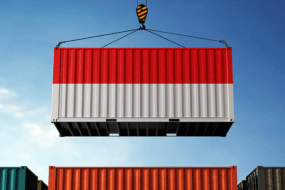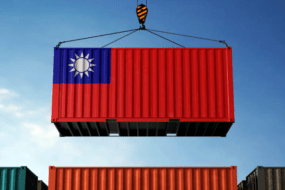- Home
- Trade News
- International trade continues ...

Risks in international trade
International trade carries with it a number of risks. One of the biggest risks associated with international trade is the potential for delays in the supply chain. With businesses increasingly globalised, their supply chains are often spread across the world.
This increases the risk of disruptions due to political or economic instability, natural disasters, and other unforeseen events. In order to mitigate these risks, companies need to insure their goods and choose reliable shipping partners. While companies can insure against some of these risks, it is not always possible to predict or mitigate them all.
Despite the various risks associated with supply chain management, international trade has been growing rapidly in recent years. In fact, many companies are now willing to take on these risks in order to access new markets and gain a competitive advantage.
International trade’s growth at present
The COVID-19 pandemic has been a devastating crisis that has affected countries all over the world and has posed several socio-economic risks. However, despite the global economic slowdown, international trade has continued to grow. According to the World Trade Organisation (WTO), global trade is expected to grow by around 3.9% in 2020, which is higher than the 3.2% growth that was forecast before the pandemic.
The DHL Trade Growth Atlas tracks global trade patterns and recent data shows that international trade in products has increased by up to 10% over pre-COVID-19 levels. This is a positive sign for the global economy as a whole, as trade is a key driver of growth.
Trade is anticipated to expand more quickly in 2022 and 2023 than it did during the previous ten years, notwithstanding the conflict in Ukraine.
It was also discovered that trade growth is dispersed among a larger range of nations. For example, China was responsible for one-fourth of the global trade increase from 2016 to 2021. According to the most recent projection from the IMF, China would continue have the highest rate of trade growth from 2021 to 2026, but its percentage of global growth will decrease to 13% from 21% currently.
Furthermore, it was demonstrated that Sub-Saharan Africa’s exports have increased significantly. Given that Sub-Saharan Africa had the lowest rate of export growth over the preceding five years, the predicted increase in this region’s exports is particularly notable. Through 2026, five of the ten nations with the greatest anticipated trade growth are in Africa, while three are in the Caribbean.
The report also identified Southeast Asia as one of the region’s new global leaders in trade growth. To be specific, the Philippines and Vietnam are two of the countries that stand out in terms of the predicted speed and magnitude of trade expansion through 2026. Furthermore, according to data from the International Monetary Fund (IMF), ASEAN is predicted to have the highest export growth rates in the world from 2021 to 2026, at 5.6%.
With reference to Vietnam, particularly, the country has grown to be one of the most sought-after locations for businesses wishing to shift production to Southeast Asia thanks to a solid industrial base, a prime geographic position, and a thriving middle class. In fact, we have a new blog on Vietnam and why the country is an attractive option for US businesses. Read it here and get a closer look.
India’s potential for a significant increase in trade growth is another interesting finding. The country’s trade volume growth rate is expected to increase from 3% to 6%, raising its scale and speed rankings from 11 to 5 and 72 to 34, respectively, making it an increasingly important player in the global economy.
Steven Altman, senior research scholar and director of the DHL Initiative on Globalisation at the NYU Stern’s Center for the Future of Management stated that “The trade landscape is shifting and presenting new challenges, but this report strongly rebuts predictions of a major retreat from global trade.”
The New York University Stern School of Business collaborated on the report’s development. The report offers politicians and business executives business intelligence covering 173 nations and examines international commerce in products, broken down by area and for both developed and developing economies.
“Our aim is for the DHL Trade Growth Atlas to become a go-to resource for understanding and navigating shifts in the global trade landscape,” CEO of the DHL Express, John Pearson, shares.
“In the current global business environment DHL can help customers rethink certain supply chains, basing them on a sensible trade-off between cost and risk, so that they are both efficient and secure.
Key findings from the report
Contrary to expectations, the pandemic has not significantly hampered international trade. Even with major supply bottlenecks limiting future expansion, global trade in products has increased by 10% from pre-pandemic levels.
The pandemic has resulted in a rapid increase in cross-border e-commerce sales. Predictions indicate that this trend will continue in the future. This growth is driven by a number of factors, including the increasing popularity of online shopping, the expansion of e-commerce into new markets, and the growing number of consumers who are comfortable making purchases online.
Despite the conflict in Ukraine, future prospects for trade expansion are still favourable. Trade growth forecasts have been revised downward, but in 2022 and 2023, commerce is expected to expand at a rate greater than it did in the ten years prior.
Further analysis on the DHL report
Despite the COVID-19 pandemic, international trade has grown. In 2020, global commerce did fall precipitously, but in 2021, it surged. This is a striking takeaway that highlights the resilience of the global economy.
One of the reasons is how many countries have worked hard to keep their borders open in order to maintain trade flows.
For example, the European Union has kept its borders open throughout the pandemic and has even introduced a “Green Lane” system to facilitate the movement of goods. Similarly, China – which is the world’s largest trading nation – has also kept its borders open and has been working to ensure the smooth flow of trade. Moreover, the WTO’s regulations have maintained the flow of international trade during the pandemic and have made the responses of various nations to the crisis more transparent.
Second, in line with the key findings of the report, the shift to online trade has helped to offset some of the decline in physical trade.
Online trade has been growing in recent years, but the pandemic has accelerated this trend, as more businesses move to sell their products and services online. This has helped to offset the decline in physical trade, which has been impacted by travel restrictions and shutdowns of businesses.
Third, governments have provided financial support to businesses to help them weather the pandemic.
To illustrate an example, the US government has provided $350 billion in loans to small businesses through the Paycheck Protection Program. Similarly, the UK government has also provided financial support to businesses, including a £330 billion fund to help businesses with the costs of switching to online trade. In Singapore, small- and medium-sized businesses (SMEs) continued to get assistance in 2021 as part of extra support measures estimated to cost S$1.2 billion in order to help them deal with the COVID-19 pandemic.
Lastly, the internet has significantly made it easier for people to buy goods and services from foreign countries.
According to the report, trade is also projected to grow faster in 2022 and 2023 than it did during the previous decade, despite the conflict in Ukraine. One of the main reasons why is because many countries have benefited from trade agreements signed in the past. These agreements have lowered barriers to trade and have made it easier for companies to do business with each other. Once more, because of the development of the internet and online shopping, it is now much simpler for consumers to purchase products and services from other nations. As long as there is a demand for goods and services, international trade will continue to thrive.
Conclusion
The continued growth of international trade is a good indicator for the global economy. Countries have worked hard to keep their borders open and businesses have adapted to the new reality of the pandemic. This has helped to offset the decline in physical trade and has ensured that trade flows continue. This is good news for the global economy, as it shows that countries are committed to keeping trade flowing despite the disruptions in supply chains and the challenges posed by the pandemic.
As DHL Express CEO John Pearson said, “International trade is considered especially important in the present context because of its power to accelerate economic growth, reduce inflation, and enable countries and companies to access multiple sources of key inputs.”
To find out more about accessing a new market, you can check out this article which shows you how to use TradeData.Pro to access Global Trade Markets: https://blog.tradedata.pro/say-hello-to-our-new-release-of-tradedata-pro/
The most trustable and reliable source for Trade Data.
TradeData.Pro is proudly made in Singapore. Singapore has been one of the world’s most politically stable countries, with an open and trade-driven economy. TradeData.Pro is presented by CIC, a government-linked company in Singapore CIC is a Join Venture of Zall Smartcom, SGX and GeTS.)
Since the launch of TradeData.Pro in 2018, TradeData.Pro has received overwhelmingly positive remarks from market. This is because TradeData.Pro has wide coverage, low cost, and fast response. There are many leading companies from different industries that have subscribed to TradeData.Pro.
TradeData.Pro was awarded with Singapore Quality Class in 2020 and Stevie Award Gold in 2021. Businesses need information to reveal trends, identify market opportunities, track competitors buyers and suppliers, and better understand supply chain potential.
Finding these critical data has traditionally been challenging. But this information do exist, but as part of government import and export filing requirement. The detailed shipment information which are within these filings constructions the core of the global trade.
TradeData.Pro has gathered and packaged these information as business intelligence. Our solution helps companies understand the flow of goods across borders and features the world’s largest searchable trade database. We do the heavy lifting for you by reviewing, standardising, and cleaning data, then delivering in an intuitive format.
Vietnam has been the hottest industry lately, to stay updated on Vietnam, you can view all these information on Vietnam in here on our platform: https://data.cic-tp.com/asia-trade-data/vietnam-import-export-data
Find the exact product you are interested in here at https://tradedata.pro/trade-database-demo/
To find out more about accessing a new market, you can check out this article which shows you how to use Trade Data Pro to access Global Trade Markets: https://blog.tradedata.pro/say-hello-to-our-new-release-of-tradedata-pro/
The most trustable and reliable source for Trade Data.
Finding these critical data has traditionally been challenging. But this information do exist, but as part of government import and export filing requirement. The detailed shipment information which are within these filings constructions the core of the global trade.
Trade Data Pro has gathered and packaged these information as business intelligence. Our solution helps companies understand the flow of goods across borders and features the world’s largest searchable trade database. We do the heavy lifting for you by reviewing, standardising, and cleaning data, then delivering in an intuitive format.
Learn how TradeData.Pro works by watching the video below! View here on Youtube as well: https://youtu.be/QQ9wG-CesI8
Business China Commodities Consumer Goods Economy Energy Export Global International Trade Markets Prices Trade Data Pro US Worldwide
Leave a Reply Cancel reply
Recent Posts
Archives
- June 2025
- May 2025
- April 2025
- March 2025
- February 2025
- January 2025
- December 2024
- November 2024
- April 2024
- March 2024
- January 2024
- December 2023
- November 2023
- October 2023
- September 2023
- August 2023
- July 2023
- June 2023
- May 2023
- April 2023
- March 2023
- February 2023
- January 2023
- December 2022
- November 2022
- October 2022
- September 2022
- August 2022
- July 2022
- June 2022
- May 2022
- April 2022
- March 2022
- February 2022
- January 2021
Categories
Recent Post
Indonesia Exports: Sunny Outlook Despite Coal, US
- June 30, 2025
- 9 min read
Taiwan Exports: Hitting Record Highs in Challenging
- June 30, 2025
- 7 min read
Forecasting a Brighter Outlook for Chile Imports
- May 30, 2025
- 8 min read
All Tags
Agriculture Automotive Brazil Business Business Opportunities Buyers China Coffee Commodities Crops Ecommerce Economic Economy Electronics Energy Environmental Europe Export Exports Future Garments Global Import India Industries International Trade Leads Leads Generation manufacturing Markets Opportunities Pharmaceuticals Prices Rice Russia Supplier Textiles Trade Trade Data Trade Data Pro Turkey Ukraine United States Vietnam Worldwide









One reply on “International trade continues to grow despite the pandemic”
[…] E-commerce is transforming sales and shopping in Brazil, as it has in many other markets around the world. As the novel coronavirus ravages the world, the Brazilian government distributes pandemic relief to most Brazilians via a digital wallet, bringing online retailers to millions of Brazilians for the first time. This caused changes in consumer preferences, with online consumers increasing by more than 40% in 2020 alone. According to the eEbit Webshoppers 2021 report, e-commerce in Brazil increased by 31% in the first half of 2021. By 2023, Brazil is expected to generate a revenue of US$48,242.1 million, positioning itself as the 12th largest eCommerce market globally and surpassing Russia in terms of revenue. You can also read more about international trade after the COVID-19 pandemic here. […]